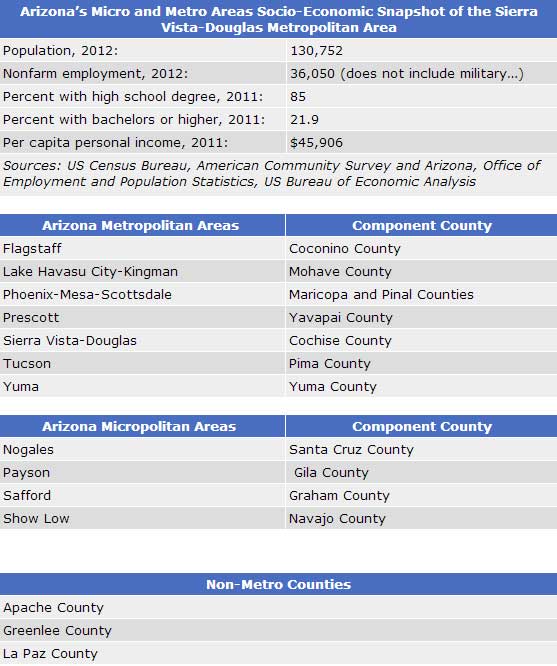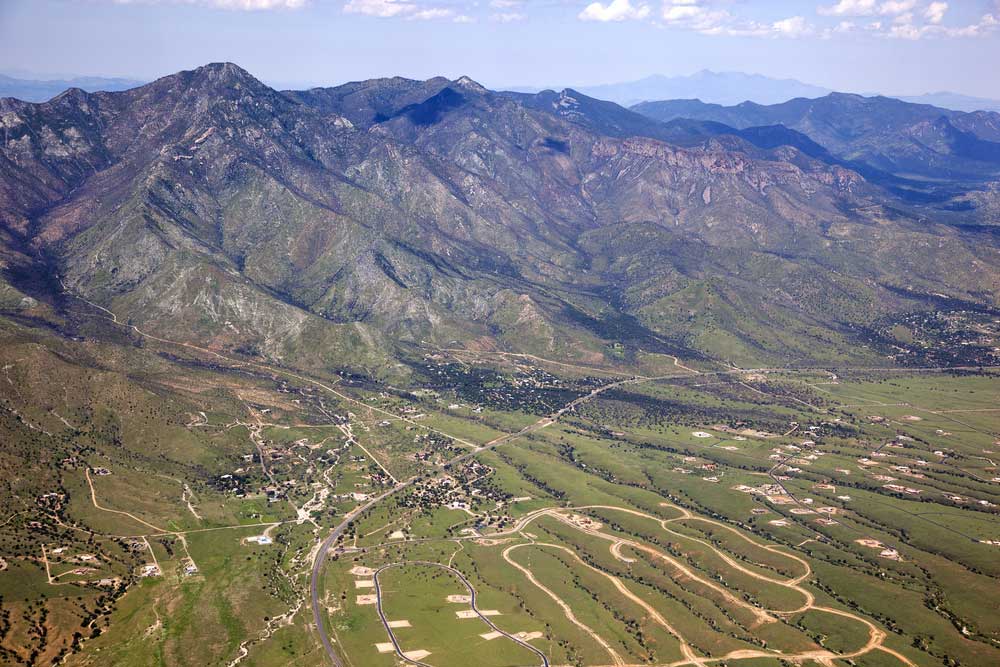Arizona has a new metropolitan area, bringing the state total to seven. The Office of Management and Budget (OMB) released the most recent list of Metropolitan and Micropolitan Statistical Areas in February 2013 and it revealed a few changes for Arizona. The title for the Phoenix metropolitan area reverted back to Phoenix-Mesa-Scottsdale (it had been called Phoenix-Mesa-Glendale for the last four years), the Safford Micropolitan Area now encompasses only Graham County (Greenlee County is no longer included). The most significant change was that Sierra Vista-Douglas has been reclassified from a micropolitan area to a metropolitan area, making it the seventh in the state and encompasses all of Cochise County. Metropolitan and micropolitan areas reflect local labor markets, as far as that is possible using counties as the basic geographic building blocks.
According to the OMB, the purpose of the metropolitan (and micropolitan) designation is to provide a nationally consistent set of delineations for collecting, tabulating, and publishing Federal statistics for geographic areas. Their release often generates interest from policymakers and economic developers, particularly for newly designated metropolitan areas. The interest is grounded in the common belief that the designation of a region as a new metropolitan area will spur its subsequent growth. Arguments supporting this view typically point to three ways in which the metropolitan designation may spur growth: (1) the newly designated metropolitan area may be better positioned to draw down federal funds, (2) the metropolitan designation may increase the amount and detail of economic information provided by federal and state statistical agencies on the region, and (3) the metropolitan designation may raise the marketing profile of the region, particularly with respect to national or multi-state site selection searches.
Research suggests that there may be something to these views, at least in the short run. Hammond and Osoba (2008) show that the metropolitan designation may spur additional employment growth, at least in the short run, although they do not find evidence of any impact on per capita personal income.
Delineating Micropolitan Areas and Metropolitan areas
The current standards for defining metropolitan and micropolitan areas were updated in 2010. These standards state that each metropolitan statistical area must have at least one urbanized area of 50,000 or more inhabitants and each micropolitan area at least one urban cluster with a population of 10,000 but less than 50,000. Counties, or the equivalent, are the geographic unit used to define metropolitan and micropolitan areas. Metropolitan and micropolitan areas are made up of a core county (or counties), which contains the urbanized area. Contiguous counties may be also included if they have a high degree of social and economic integration with the core county (or counties). This integration is often measured by commuting flows. Within Arizona, only the Phoenix-Mesa-Scottsdale metropolitan area contains more than one county, with both Maricopa and Pinal.
If you are thinking that Sierra Vista does not seem to be large enough to be considered a metropolitan area, your instincts are good. With the 2010 Census population being 43,888, the city of Sierra Vista does not quite reach the magic figure of 50,000. However, an urbanized area need not stop at a city border. Urbanized areas are defined by the Census Bureau after each decennial census primarily based on residential population density at the census tract and block levels. The Sierra Vista Urbanized Area, which also includes an area south of the city referred to as Sierra Vista Southeast, was designated in March 2012 with total population listed as 52,745. This paved the way for Sierra Vista-Douglas to be considered a metropolitan area when the list of metropolitan and micropolitan areas was released in February 2013.

Sources: US Census Bureau, American Community Survey and Arizona, Office of Employment and Population Statistics, US Bureau of Economic Analysis
References
Hammond, George W. and Brian J. Osoba. 2008. “The Growth Impact of the Metropolitan Statistical Area Designation,” Annals of Regional Science, 42, 307-319.
Photo of Huachuca Mountains near Sierra Vista, Arizona from above courtesy Shutterstock.com.





